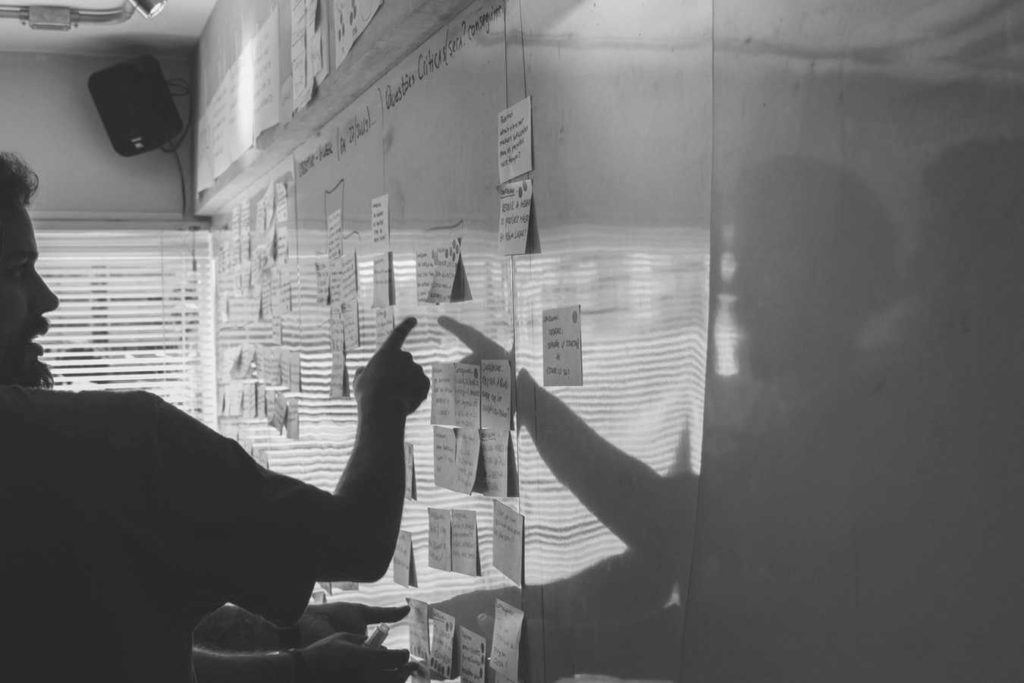Long before the popularity of Agile software development, programmers found which practices correlated to success.
First, these practices were cataloged as Extreme Programming and then utilized as enablers for all popular Agile techniques and Lean approaches.
Agile is a widely-used project management methodology that contains small development cycles (sprints) aimed to focus on bringing continuous improvement in a product (or service). Sprints mean pre-determined timeframes given to the team to complete particular tasks. A sprint usually ends with a review, when team members discuss their performance and possible ways for improvements.
Nowadays, Agile transformation is a trend and it is widely adopted by different industries with the main focus on building products or services through a continuous cycle of small changes.
As opposed to the Waterfall approach, which uses a step-by-step technique for product development, Agile software development is focused more on bringing flexibility with constant updates. This is what distinguishes Agile from the traditional Waterfall approach (with its step-by-step development) in their eternal fight known as “Agile vs Waterfall“.
However, Agile has a clear advantage in this competition just because the latest researches have demonstrated that more than 70% of companies nowadays are using the Agile methodology for their needs. This is the best confirmation of the popularity of Agile techniques for product and service development.
What makes it so popular? Every Agile-addicted professional has own answer. However, the secret of Agile popularity should also be related to its outstanding practices.

Contents
What Are Agile Best Practices?
1. Focus on customers
Focus on customers is the constitutive characteristic of the Agile methodology. Agile teams should constantly provide customers with all the required information and inform them about the work progress. Such continuous communication should be a part of internal teamwork as well.
2. Iterative development
Agile-based teams choose the amount of work possible to be done within available hours.
Iterative development means that big projects are broken down into smaller chunks, and testing is done in repetitive cycles. This practice allows getting a clear perspective about new features that should be added to the final product or service. This also contributes to a more flexible development.
3. Product backlog
As all project’s tasks are cut into pieces, a product manager (or product owner) needs to determine how many resources each task takes.
Typically, a product backlog contains product features, bugs, knowledge acquisition, and some technical work.
One more essential objective for an Agile team is to prioritize all backlog items based on the customer’s business needs. The higher a certain item is, the sooner developers will work on it. Usually, top-located items are more clear and detailed in comparison with the lower items.
Product backlog management should obligatorily involve product backlog refinement sessions (grooming sessions) that are aimed to keep the backlog updated, clean, and orderly. Ongoing backlog grooming is needed within each sprint to refine items to be ready for future sprints.
4. Scrum ceremonies
Scrum ceremonies are inherent components of the Agile software development process. These are not just meetings for meetings; they are aimed to provide Agile teams with the tools to get work done in a structured way and inspire each participant to collaborate effectively.
Weakly-managed meetings can overwhelm calendars. The events are typically arranged by a product manager or a product owner and last about 10-15 minutes.
- Sprint planning combines team members to plan and define what should be completed in a coming sprint. The event requires the participation of a Product Owner, Scrum Master, and developers. It typically happens before the sprint begins and lasts 1-2 hours.
- Daily Stand-up (Daily Scrum meeting) is a 15-minute gathering that is aimed to sync everyone in the software team. It shouldn’t be detailed and long but must be informative. It’s recommended to arrange it once a day, in the first part of the day.
- Sprint Demo is focused on demonstrating what the team has shipped in the given sprint. The meeting contains the demonstration of the work finished within the iteration, the celebration of the team’s accomplishments, and the feedback from stakeholders.
- Sprint Retrospective covers what did and what did not go well. The key goal of this review meeting is to make the next sprint better. The event is usually run at the end of the sprint after the demo and lasts for about an hour.
5. User stories
Agile teams describe the product’s position in a specific way, meaning “I want to … because …” template. A specific unit of work that should be completed in one sprint is a user story.
User stories contain description, acceptance criteria, and the estimation of the time. If stories are too complex, they are broken into smaller pieces. It helps to process them within a few sprints.
6. Agile roles
There is a wide range of specific roles in the Agile methodology.
The set of these roles consists of:
- Team Lead or Project Lead
- Scrum Master
- Team members
- Product Owner for Scrum and On-site customer for XP
- Stakeholders
Extra members can also be involved to let the team access particular tech or domain expertise.
7. Time-boxing
The time-boxed approach regulates deliverables and deadlines, for example, the duration of sprints that range from two weeks to a month. Scrum ceremonies are also stiff. It is also used for individuals to address personal tasks in a smaller time frame.
8. Value stream analysis
Agile introduces two principles:
- Define the product depending on user stories, based on business analysis.
- Determine dependencies between the business and technical functionality.
9. Continuous Integration
The integration allows development teams to keep code up-to-date. All code should be verified before it is connected with the old code. It makes the testing of new user stories easier.
After merging new code with the old one, unit tests and regression tests are executed.
10. Test-driven development
The performing of programming adaptive tests precedes any session. After that, the team writes the code specific to user stories.
11. Using Burndown Charts for sprints
A burndown chart is a convenient way of monitoring the sprint progress. The chart graphically visualizes the work that has been done and the total work remaining.
This tool informs the entire team about the project scope and helps to anticipate possible scope creep.
12. Programming in pairs
Any programmer is an individualist in all likelihood. However, the programming in pairs approach means the implementation of user stories in pairs (by a primary and secondary developer).
The expert cooperates with the newcomer, and there is one owner of the user story. The other programmer only provides support and can rotate.
13. Requirement prioritization
Requirement prioritization in Agile helps project and product managers to determine which specific product requirements should be included in a certain release.
Requirements should also be prioritized to minimize risks during development. Thanks to the popular available prioritization techniques and frameworks, development teams can set priorities correctly and in a professional way.
How to scale Agile practices for global teams?
Companies often want to scale the Agile development process, especially when the team consistently produces high-quality outputs. Agile allows multiple teams to work simultaneously on a single product release.
The teams may synchronize planning and execution work applying an Agile delivery solution. Agile practices are also used across different areas, business units, or geographic locations to reach all advantages of agility on various types of projects.
Scaling the Agile methodology looks more effective when companies implement Agile methods regardless of how complex or large the project. Key values and principles for how people work together make Agile methods sustainable.
The list of Agile practices mentioned above may contain more positions related to requirements, design, testing, and process and organization issues. If you have anything to add, please, feel free to comment on this article.





